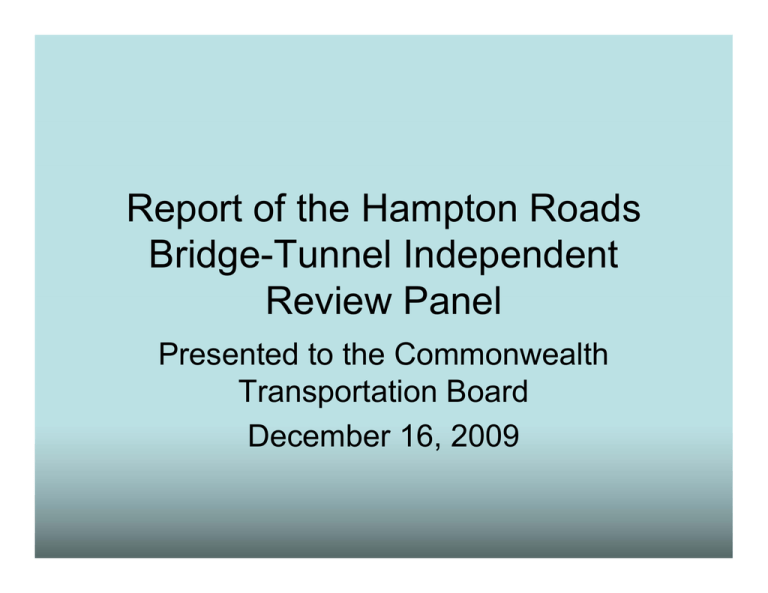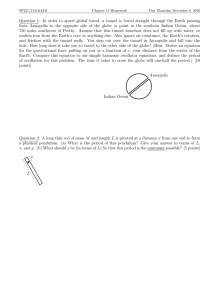Report of the Hampton Roads Bridge-Tunnel Independent Review Panel Presented to the Commonwealth
advertisement

Report of the Hampton Roads Bridge-Tunnel Independent Review Panel Presented to the Commonwealth Transportation Board December 16, 2009 Independent Review Panel • Convened by Commissioner Ekern in response to July 2nd flooding event • Included experts from other tunnel facilities and emergency management agencies • Recommendations developed over the course of three meetings Panel Charge • Review policies and procedures used for tunnel operations, maintenance, technology and management at Hampton Roads • Review similar policies and procedures used at other tunnel facilities • Make recommendations for needed improvements to ensure use of best practices Panel Members • • • • • • • • • • • Philip J. Tarnoff (chair), Director, Center for Integrated Transportation System Management, University of Maryland Steven Mondul, Deputy Assistant to the Governor for Commonwealth Preparedness Wallace Twigg, Region V Director, Virginia Department of Emergency Management Capt. R. Daniel Plott, Bureau of Field Operations, Virginia State Police John M. Keifer, Director of Public Works, City of Norfolk Lynn Allsbrook, Public Works Operations Manager, City of Hampton Steve Ernst, Senior Engineer for Safety and Security, Federal Highway Administration Jeff Holland, Executive Director, Chesapeake Bay Bridge-Tunnel Steve Napolitano, General Manager, Port Authority Bus Terminal and Lincoln Tunnel, Port Authority of New York and New Jersey Don Smith, Tunnel Maintenance Operations Manager, Maryland Transportation Authority Connie Sorrell, Chief of System Operations, Virginia Department of Transportation Summary of Findings • Similarities identified between HRBT and the facilities represented by panel members including: – Similar organizational structures with tracks for operations and maintenance (O&M) – On-the-job training for control room O&M personnel – Resource constraints requiring prioritization of maintenance activities – Established visual inspection schedules of tunnel elements Summary of Findings (2) • A number of significant differences were also noted – The emphasis on maintenance is more apparent at other facilities – Other facilities have a 24/7 maintenance presence on-site to quickly identify and resolve maintenance issues – External inspections occur more frequently at other facilities Panel Recommendations • Six recommendations are offered to enhance operations and maintenance at all VDOT tunnels for all types of potential incident conditions • Since many recommendations are interrelated, a phased implementation plan should be developed Recommendation #1 • Conduct a risk assessment to identify the critical events that would result in the closure of the facility or risk to the safety of facility users – Identify critical events – Evaluate options for monitoring of identified critical subsystems and response to critical subsystem failures Recommendation #2 • Evaluate the staffing patterns and expertise required for each functional unit – Evaluate staffing patterns and structure to include distribution of staff in maintenance vs. operations, number of staff needed by function, skills required by position, and needed supervisory positions – Evaluate the effectiveness, costs, and issues involved consolidation of tunnel traffic management functions with the TOC – Prepare a staff development plan for tunnel staff that clearly defines requirements and expectations both for existing positions and advancement – Implement a formal training plan for maintenance and operations staff that includes exercises and drills – Institute 24/7 maintenance staffing to ensure immediate response to events Recommendation #3 • Enhance facility management plans and procedures for tunnel facilities – Enhance maintenance plans so that preventative maintenance and inspection requirements are defined and documented – Use the risk assessment to define response procedures for failure of critical systems – Continue the implementation of a management system that can drive a proactive asset replacement plan to minimize the risk of failure of aging subsystems – Institute additional measures to monitor maintenance activities – Annually, conduct an independent inspection of a section or system as a quality control/quality assurance measure – Continue efforts to automate current manual logging processes in the tunnel control room Recommendation #4 • Enhance traveler information dissemination during incidents and other major events as a means of reducing overall traveler delay – Evaluate traveler information resources to ensure that information is communicated at sufficient distances – Increase public awareness of 511 Virginia capabilities – Develop a public education program to ensure motorists know the appropriate response to an incident inside the tunnel Recommendation #5 • Enhance the emergency plan coordination with localities and first responders – Develop signal timing plans for incident response across jurisdictional boundaries – Increase outreach to first responders Recommendation #6 • Implement periodic reviews of security related plans and policies Conclusion • The recommendations presented here represent a practical set of comprehensive measures that can reduce the chances that an event such as occurred on July 2nd could recur • Many recommendations are interrelated and therefore selective implementation of individual recommendations could reduce their overall impact






